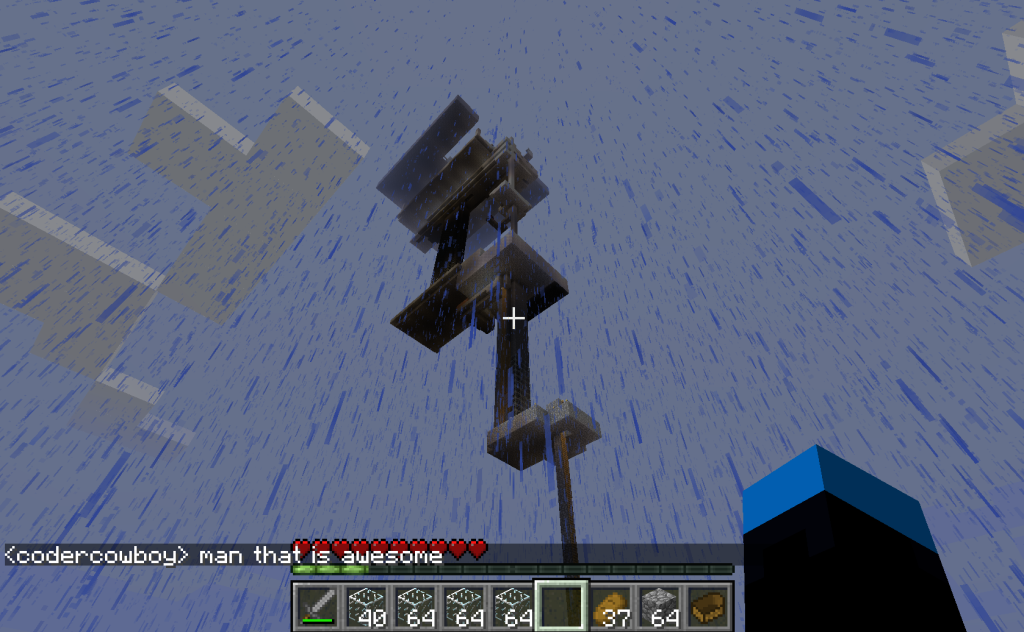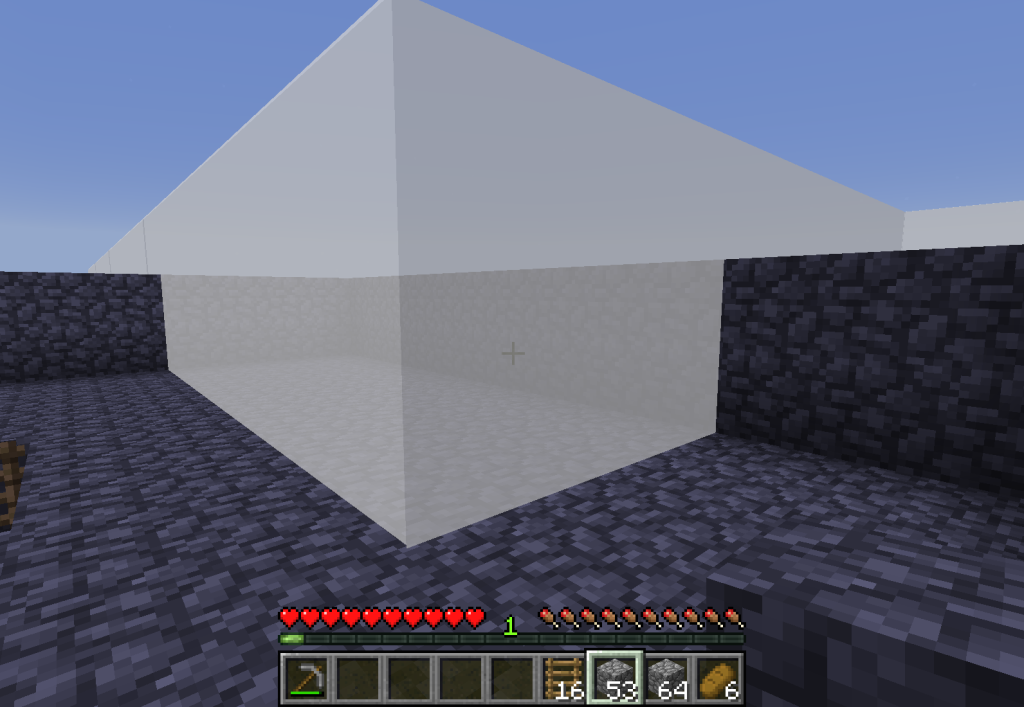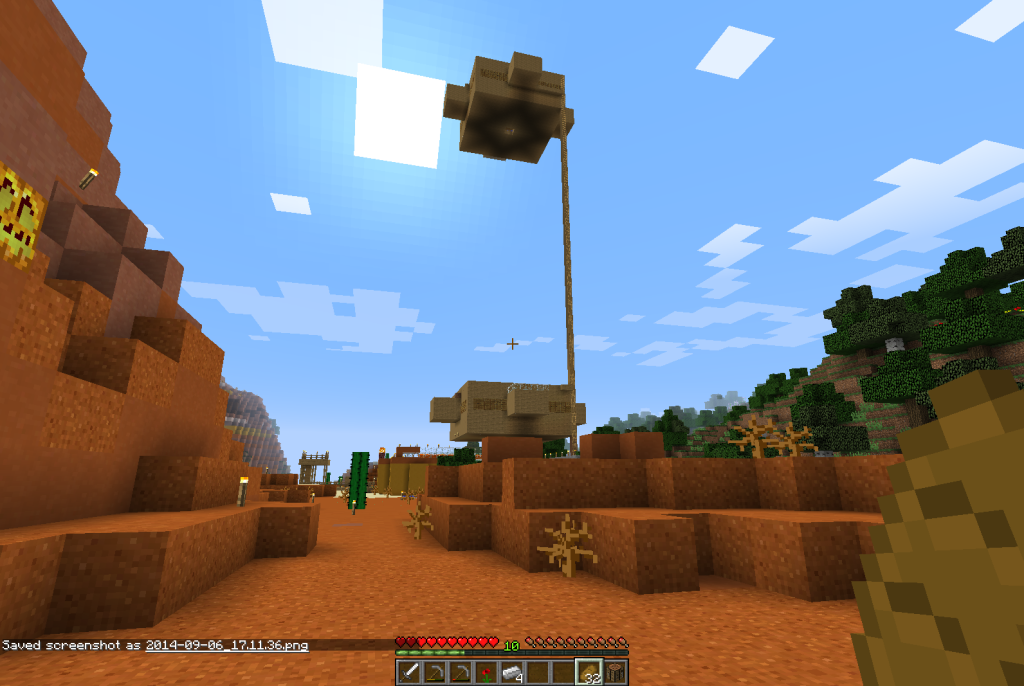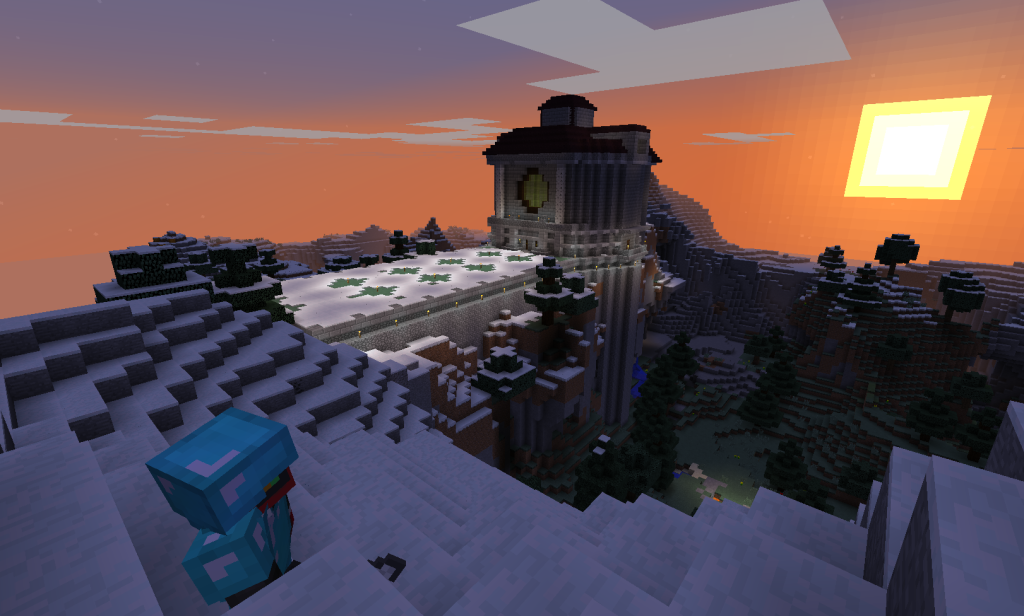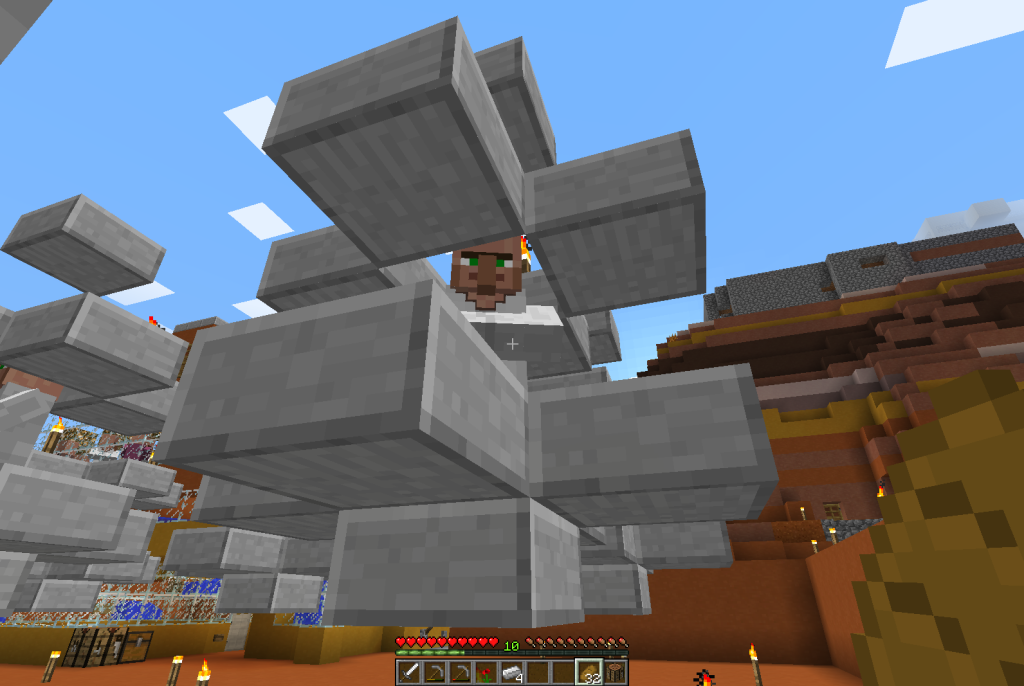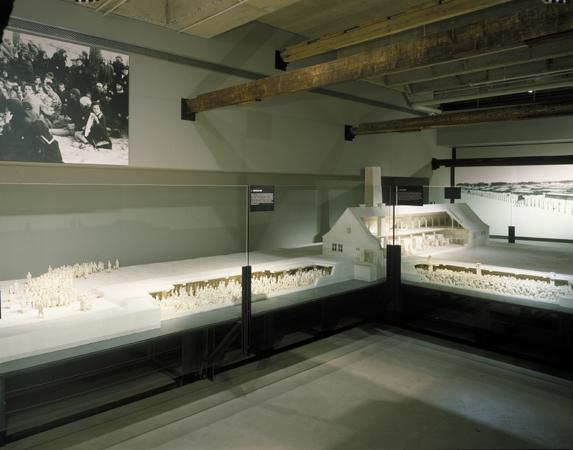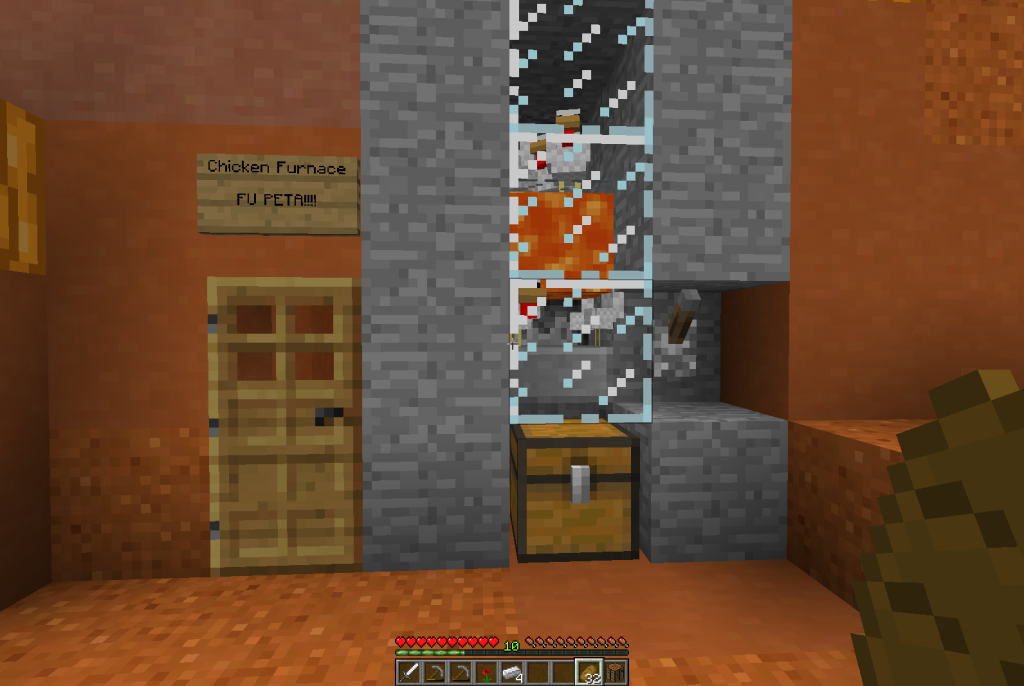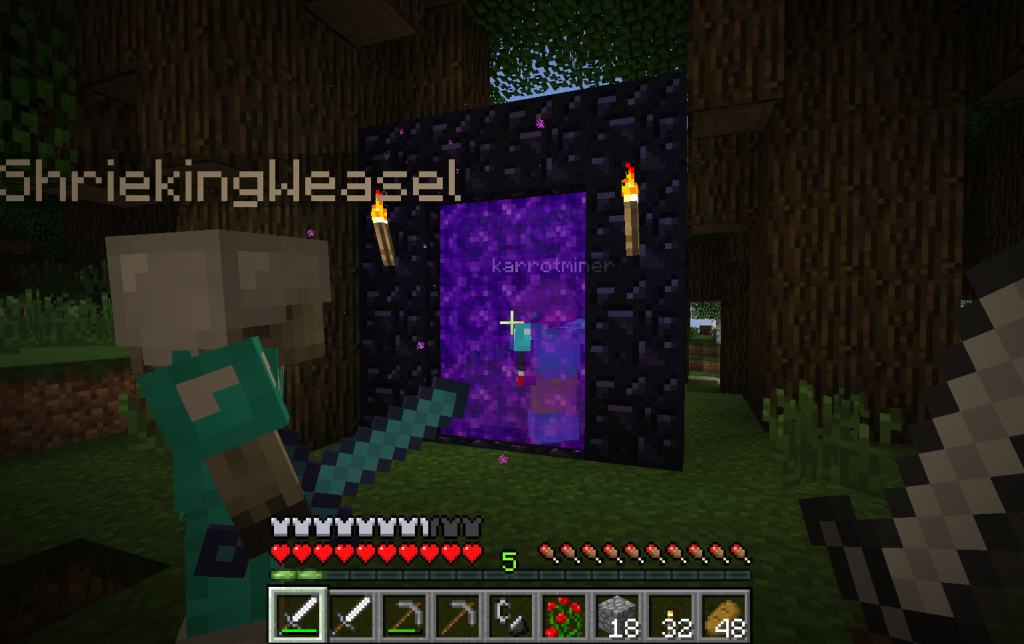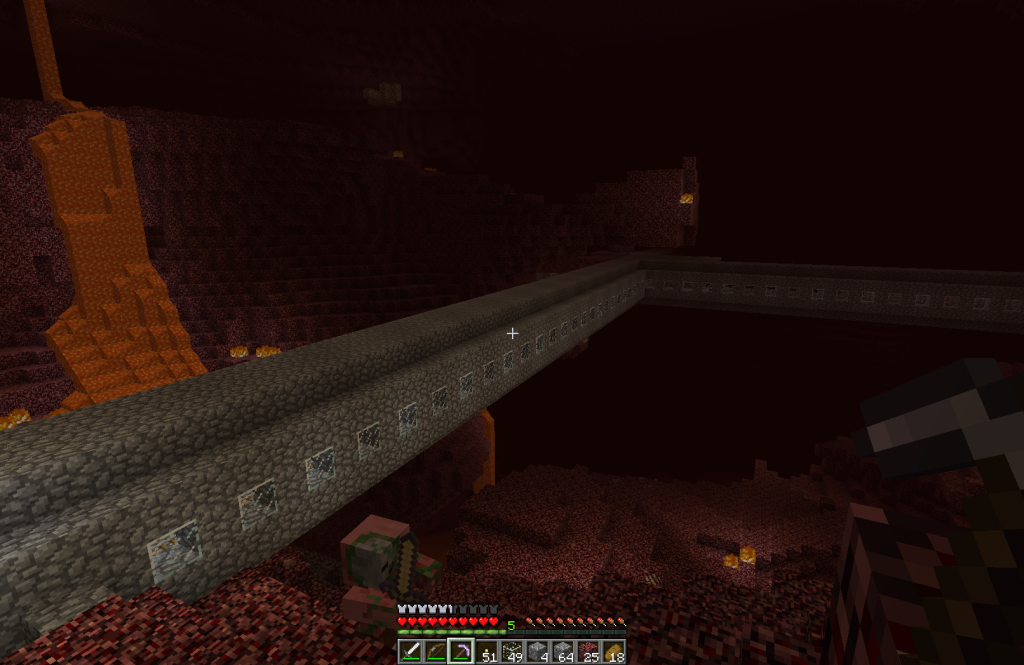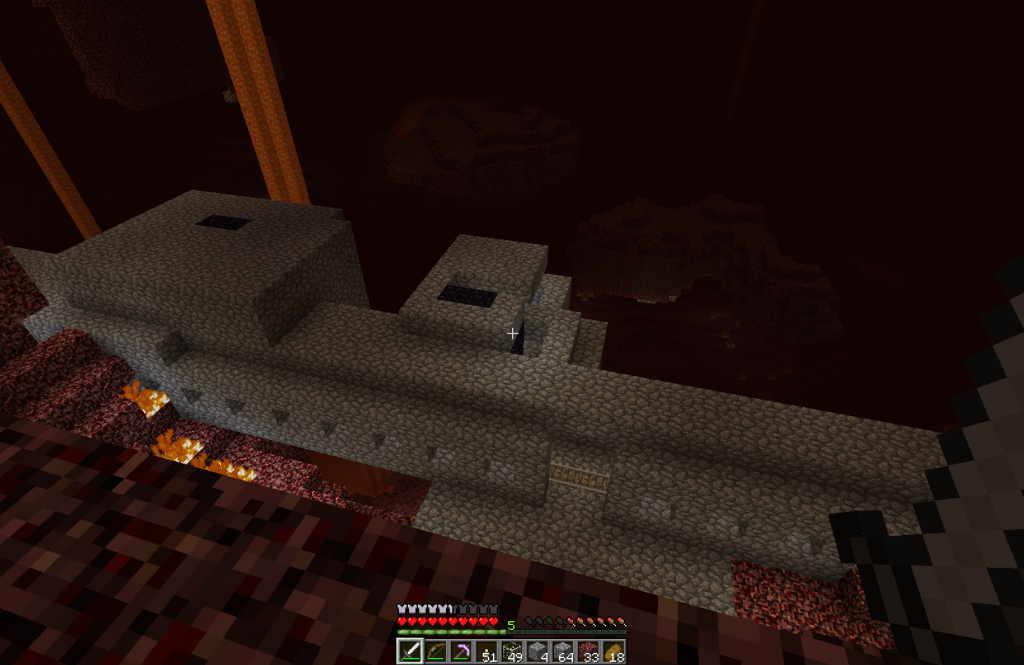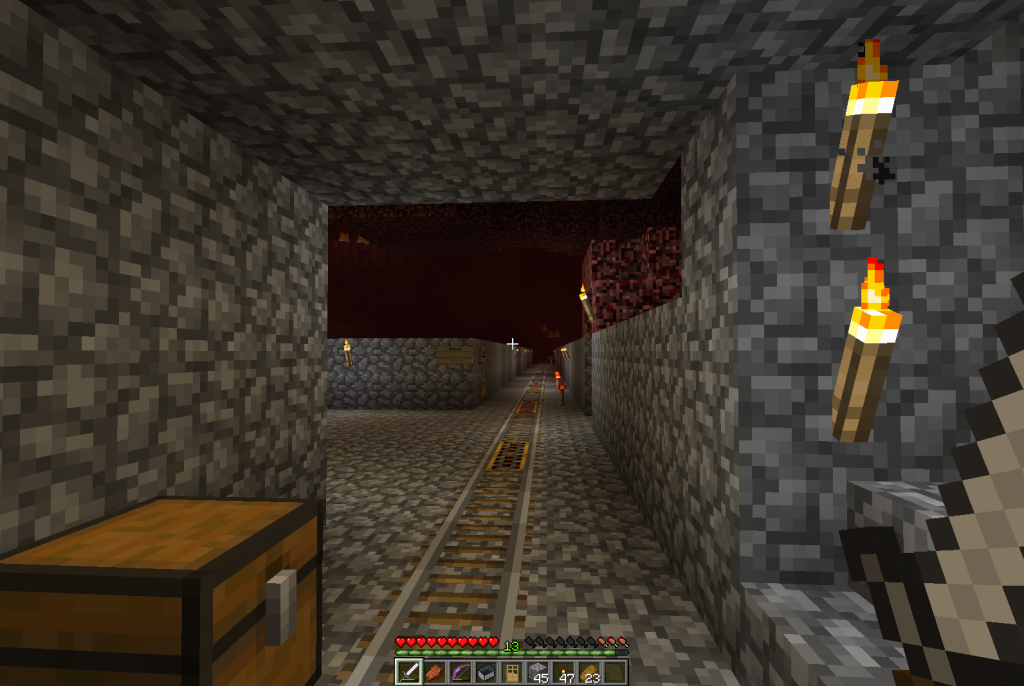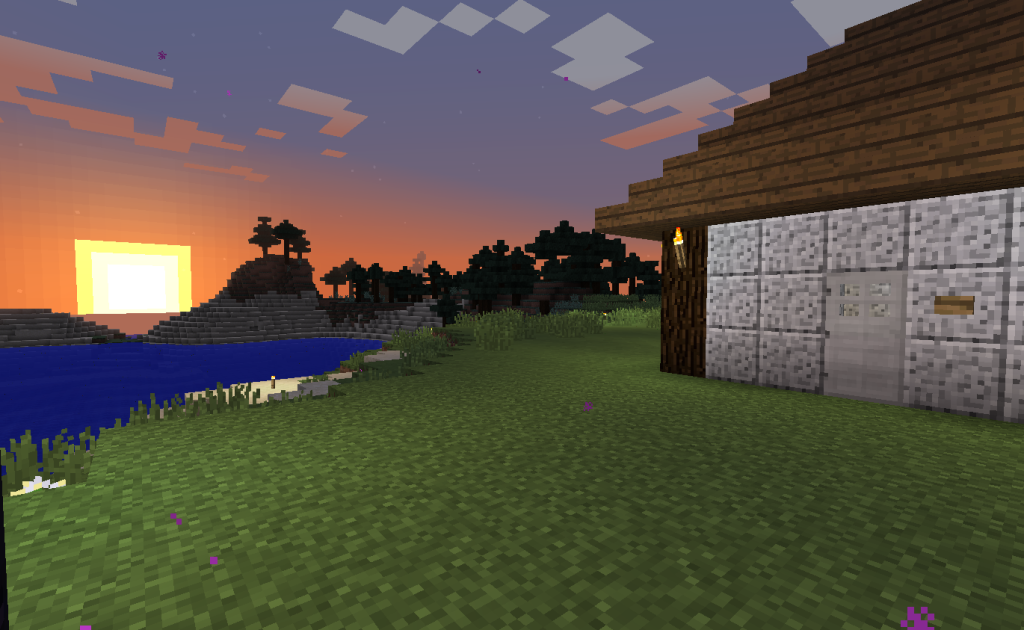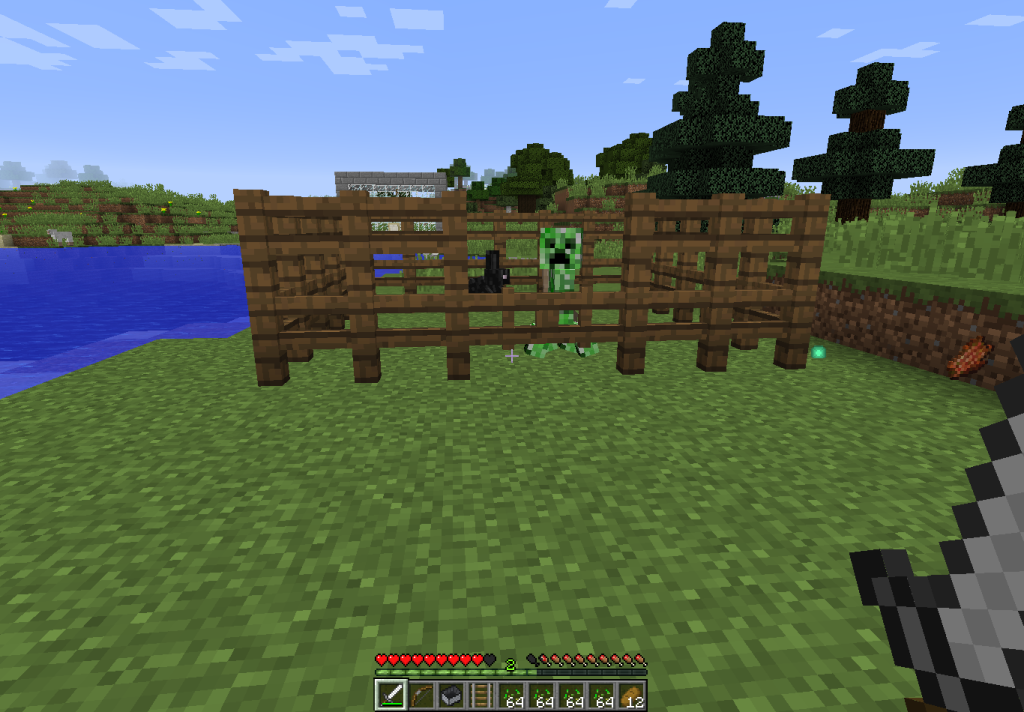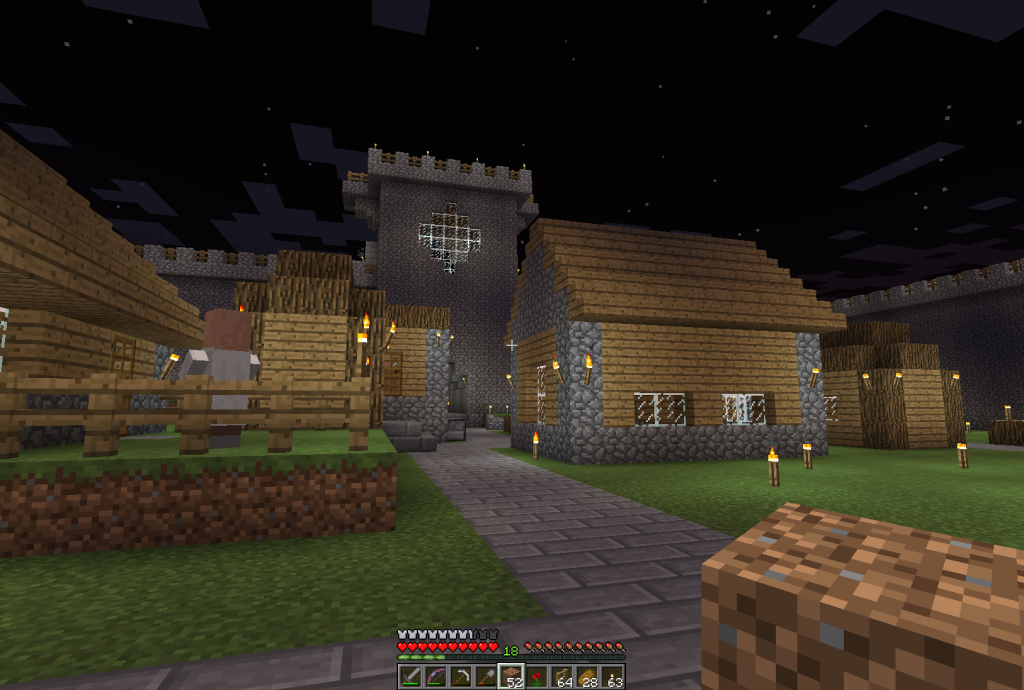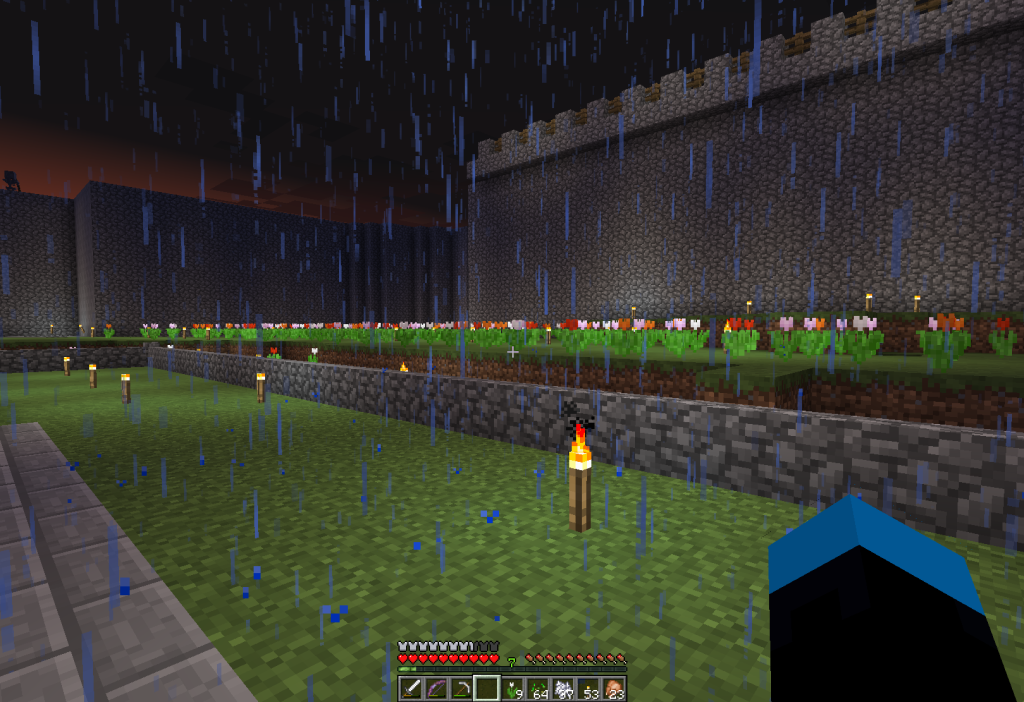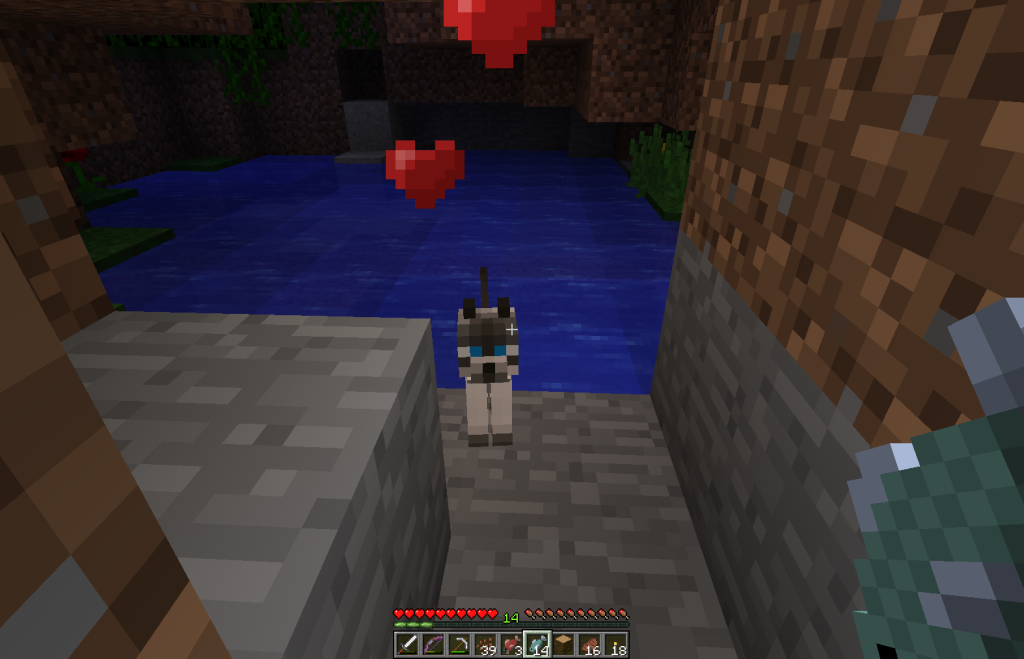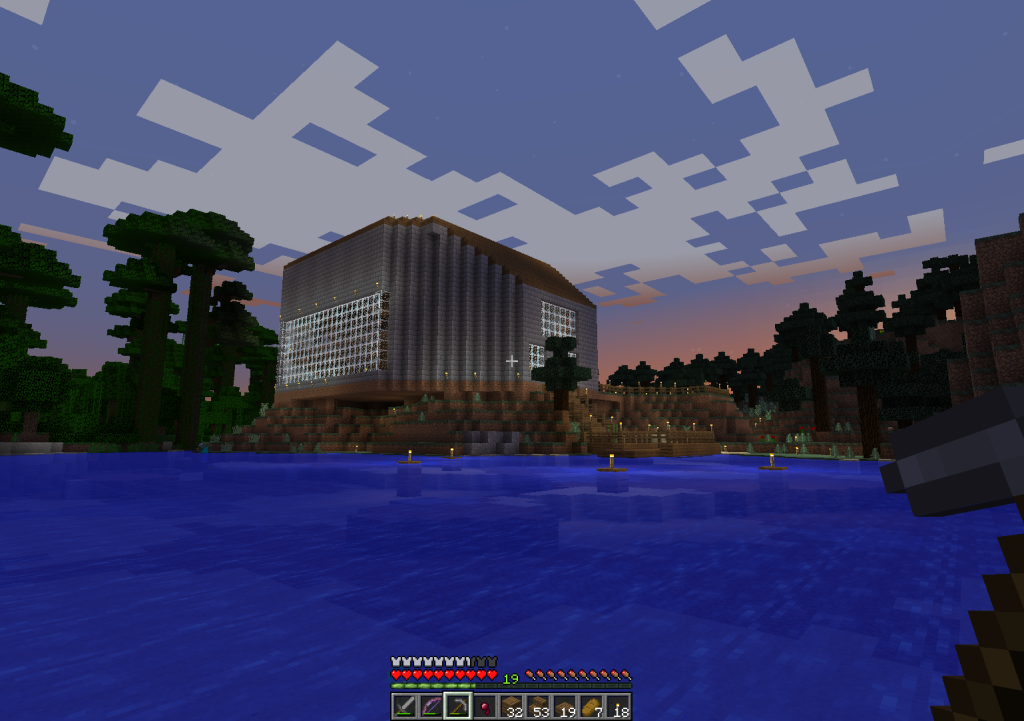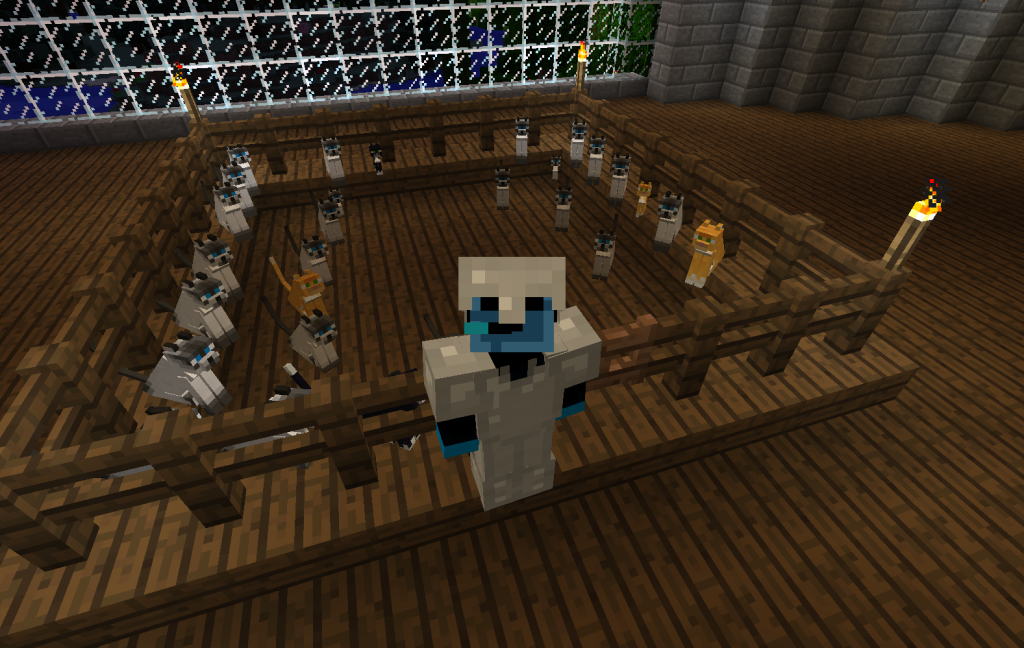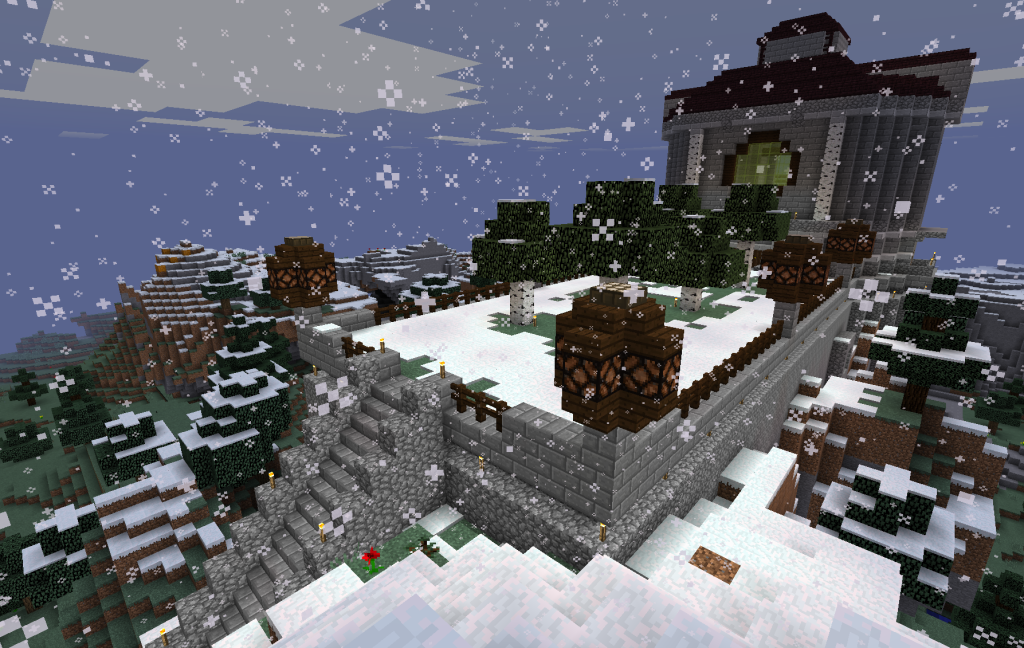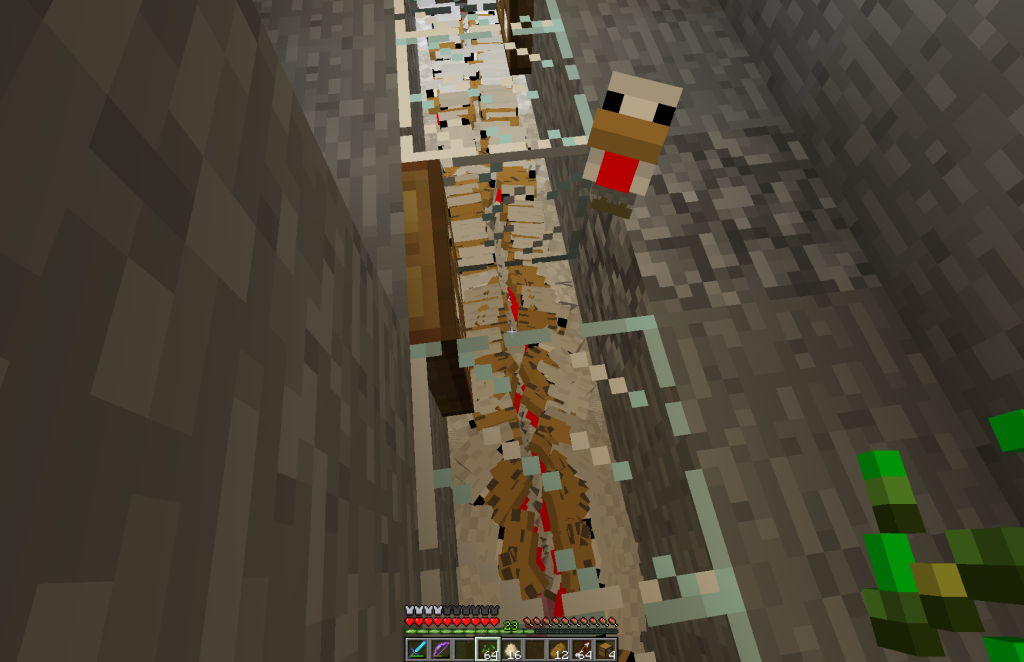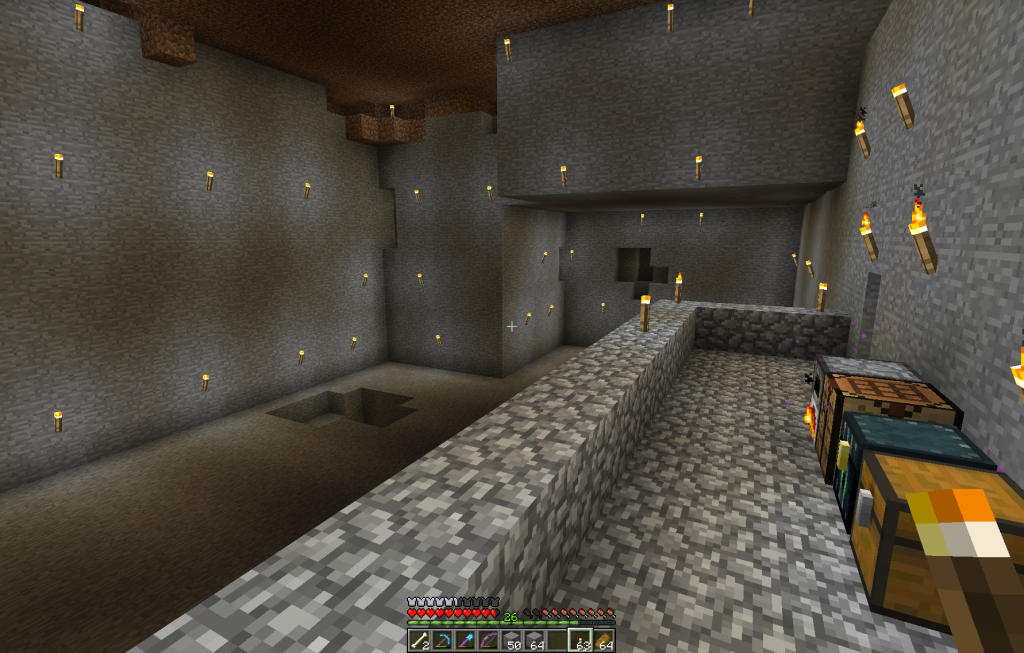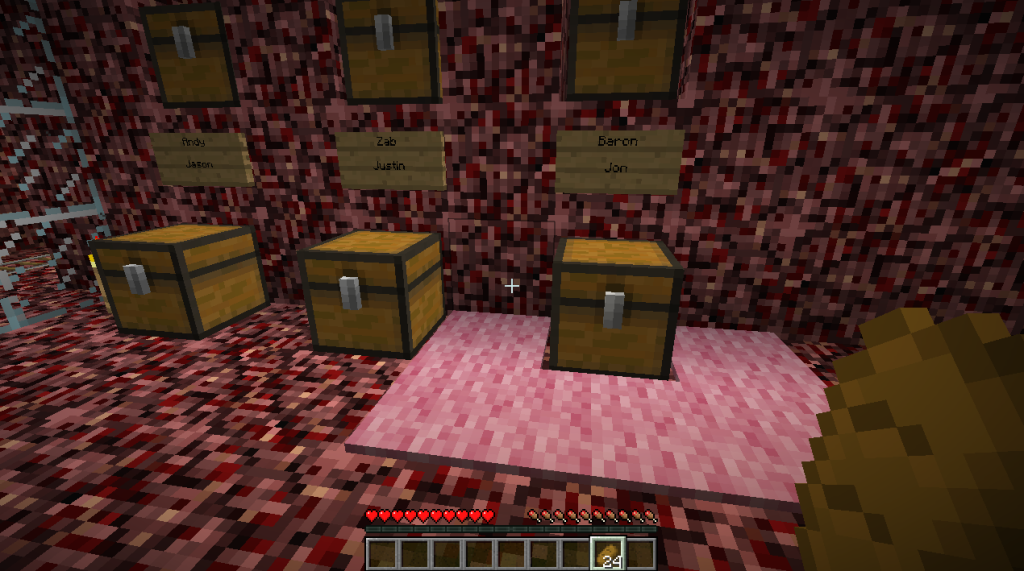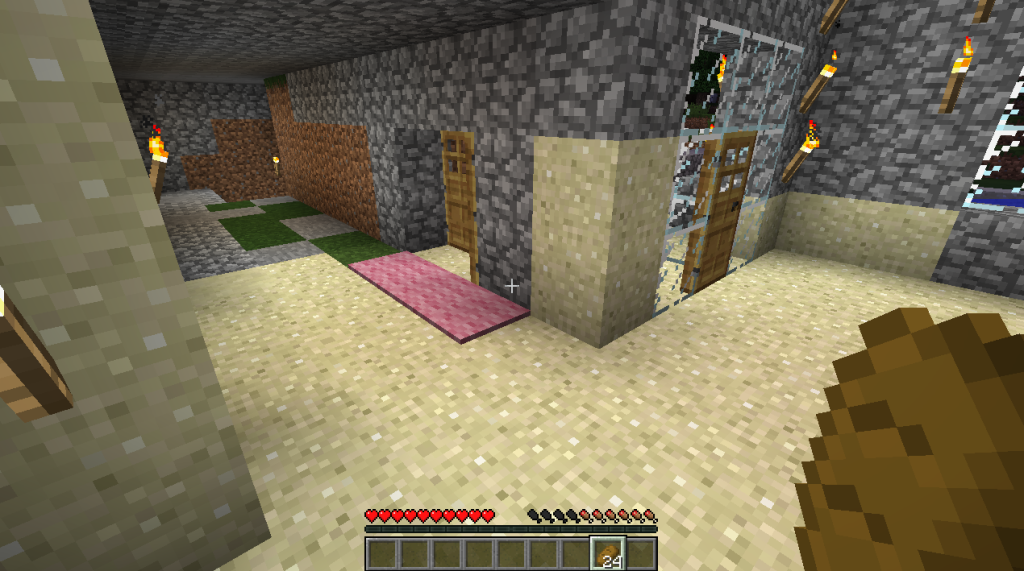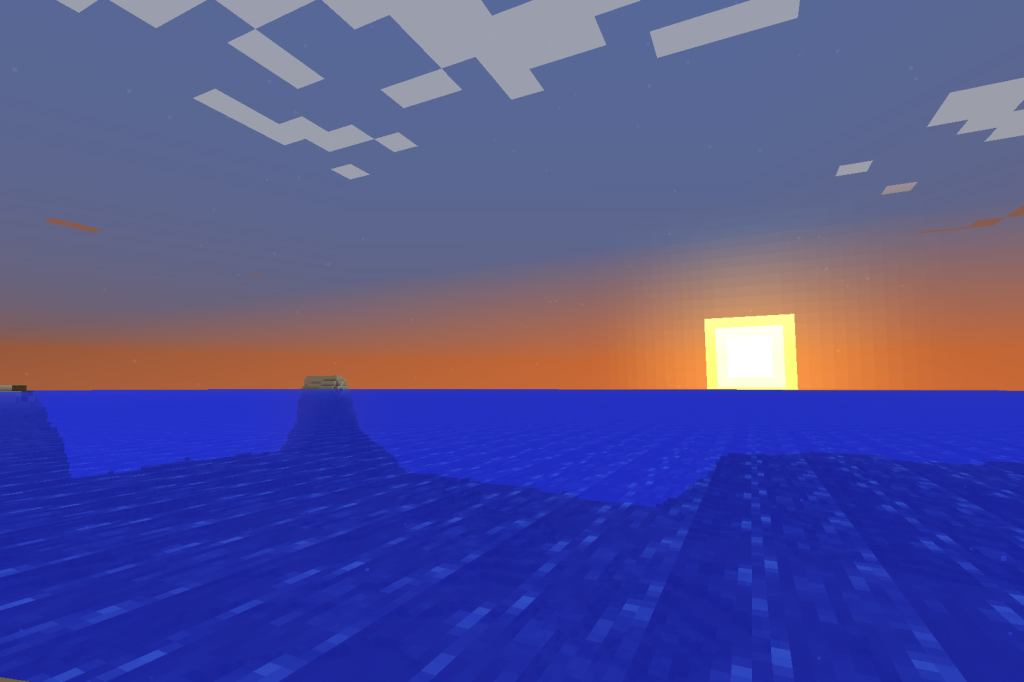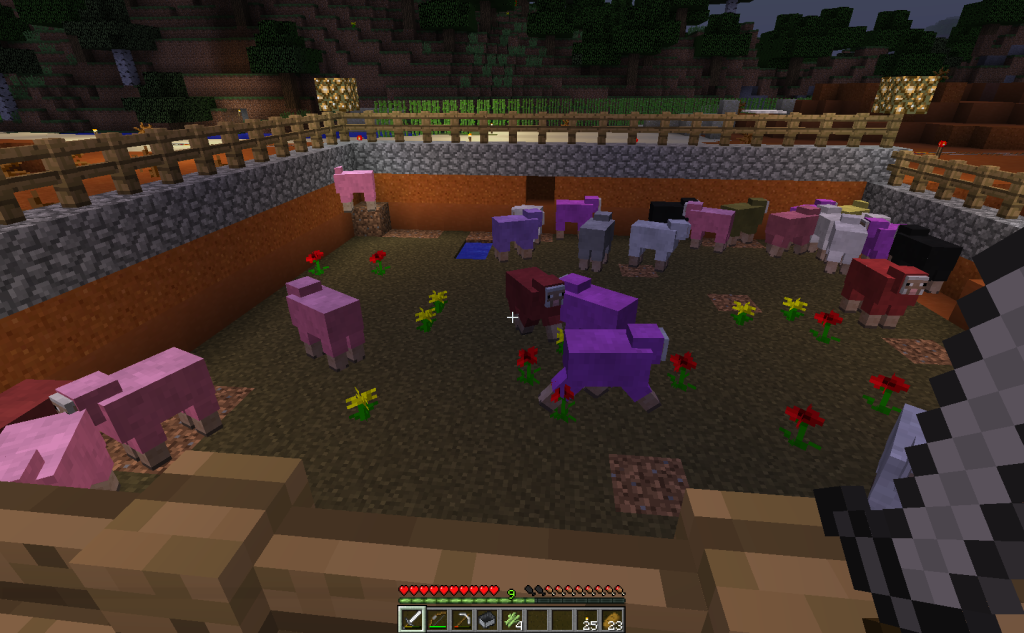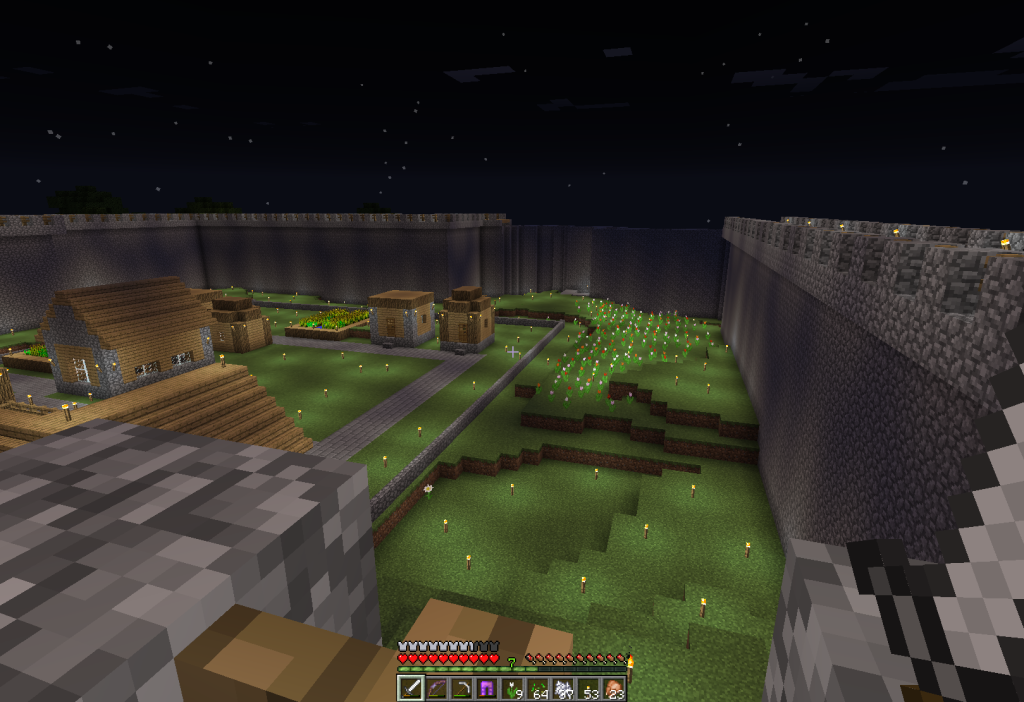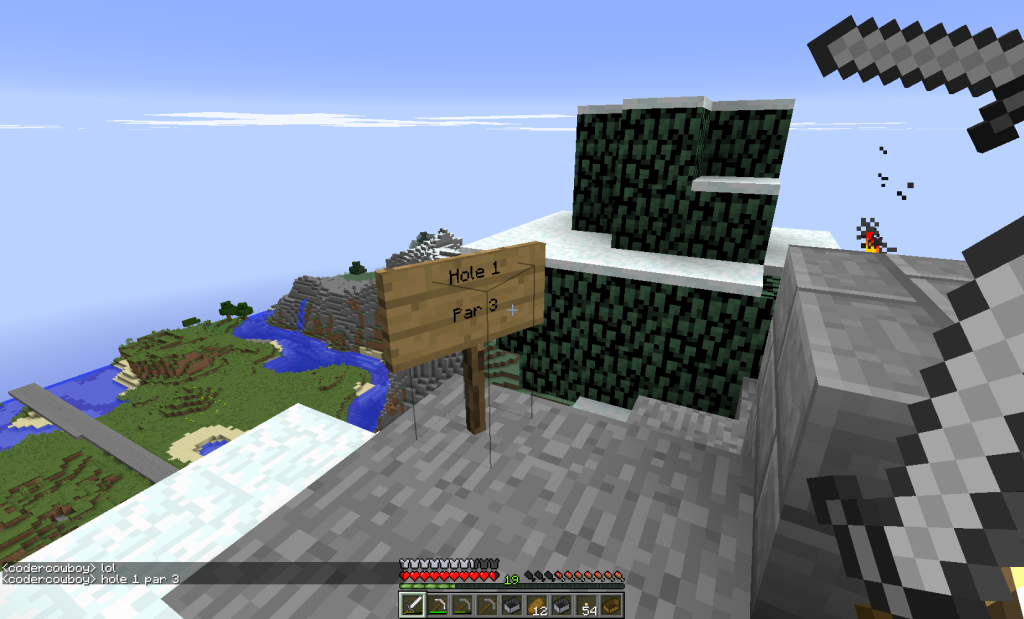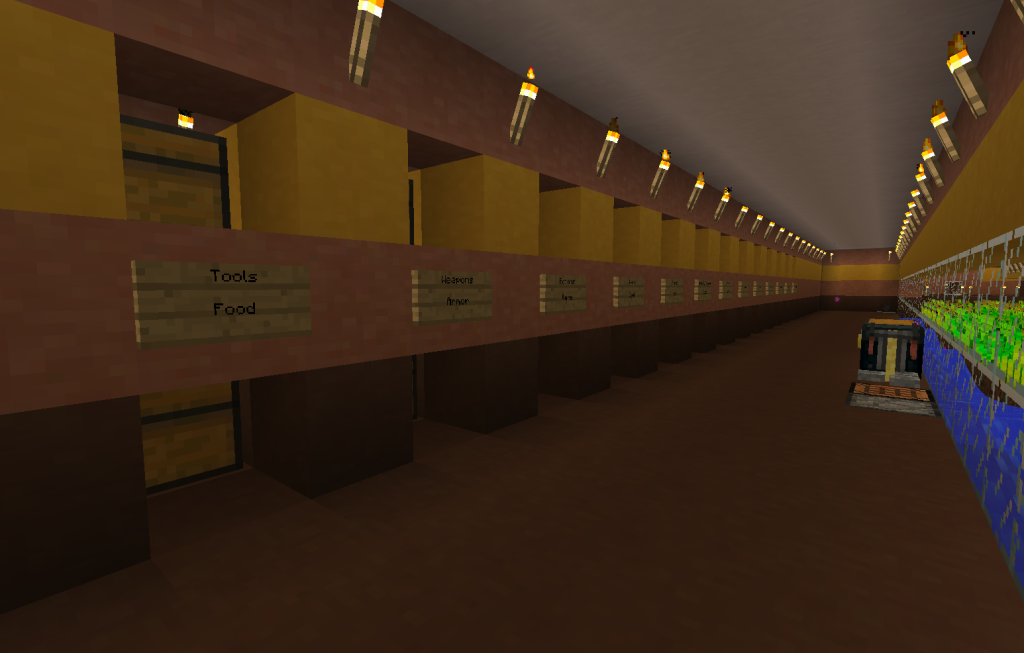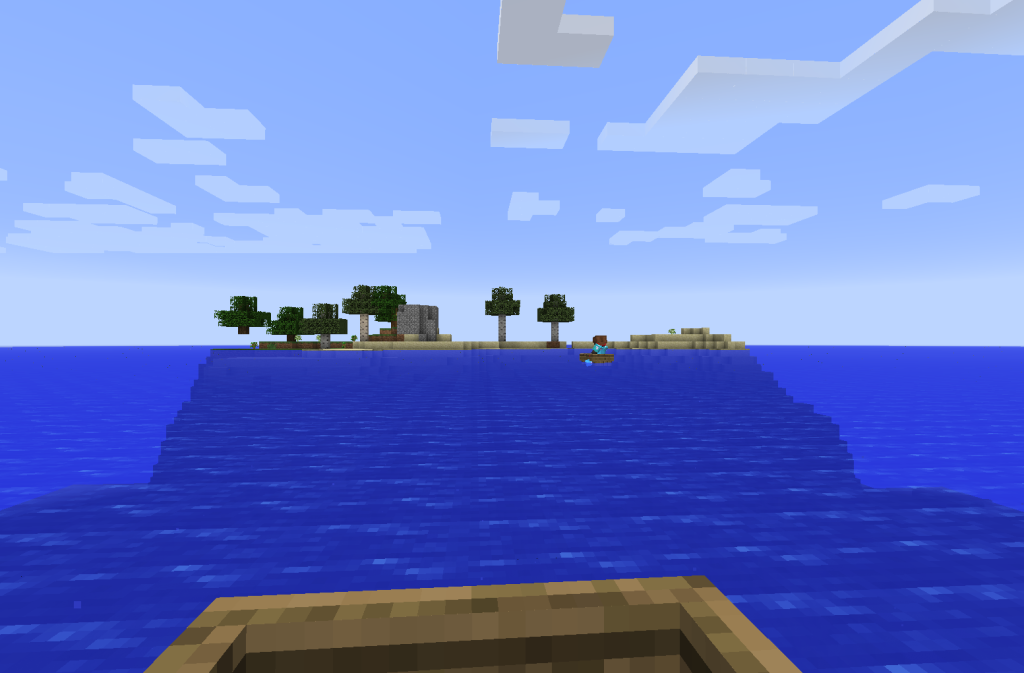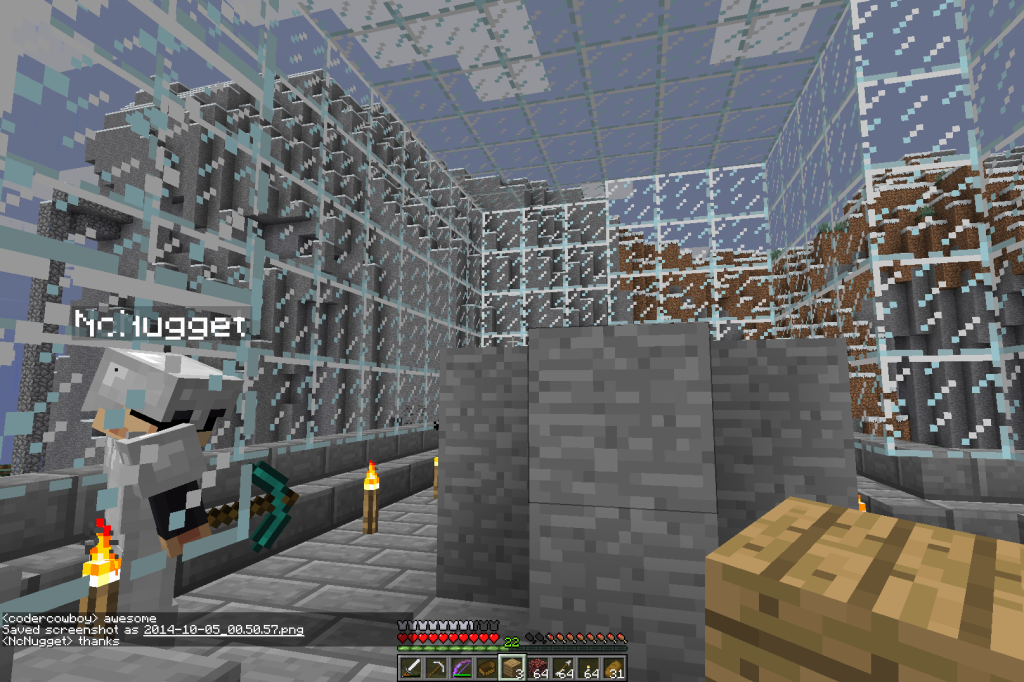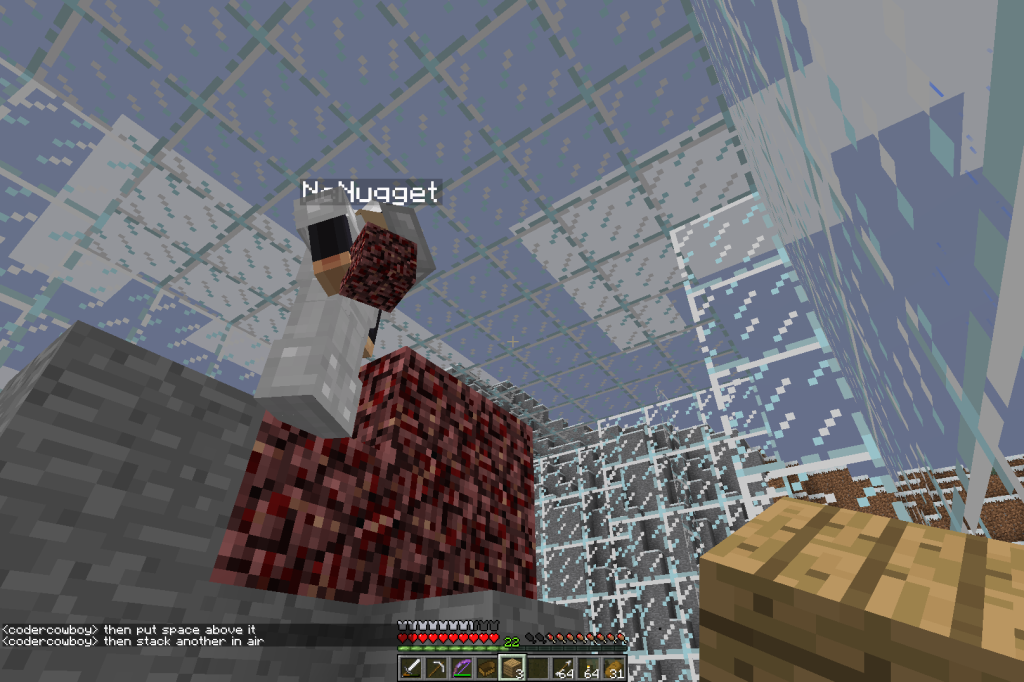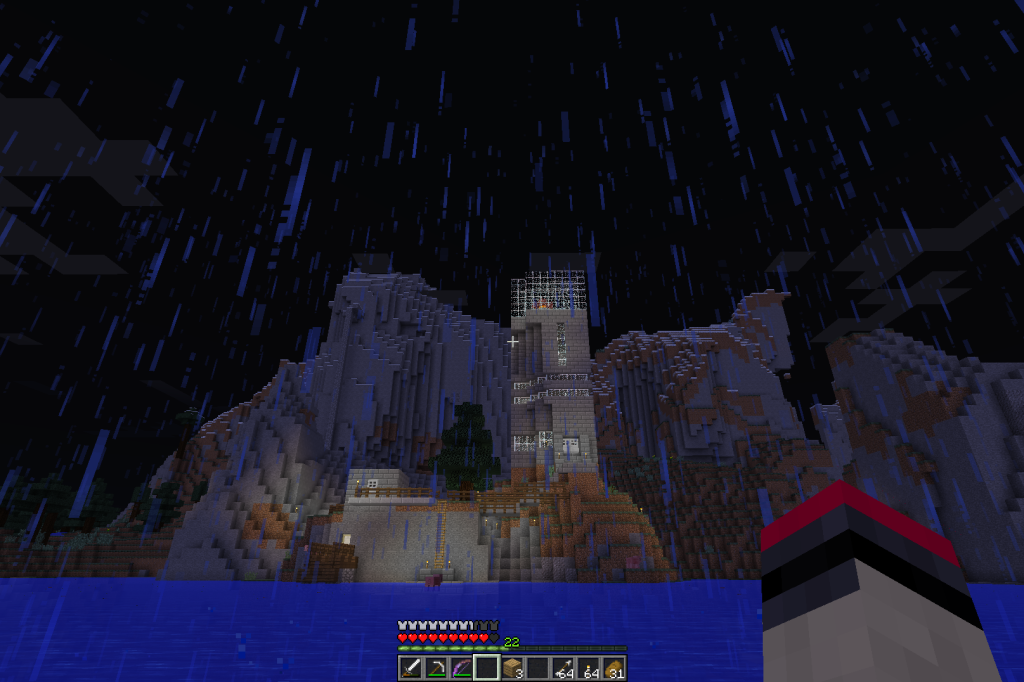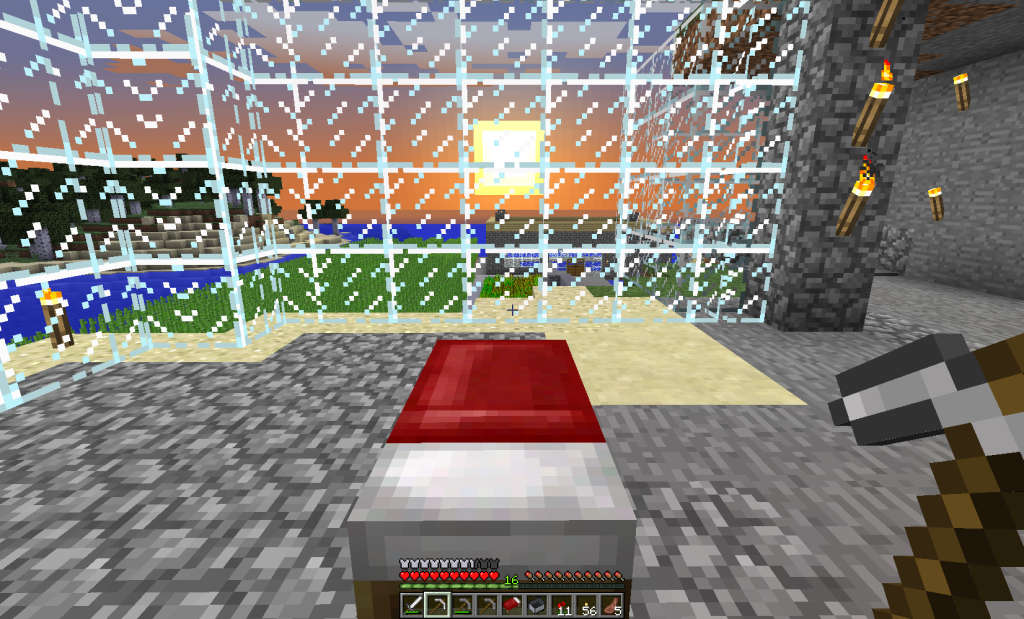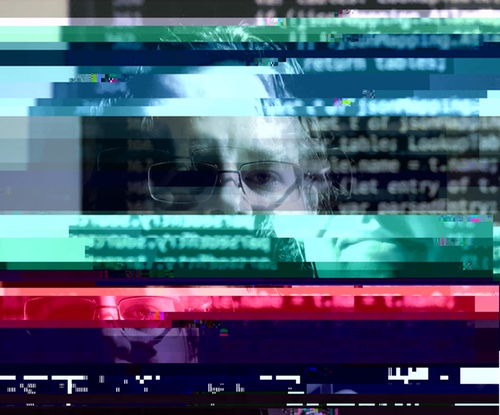You should start at the beginning: Minecraft – A Software Engineer’s Experience Part 1
I started playing Minecraft early this past August. What started as an innocent and fascinating experience in a “real world” simulator eventually took a turn. I spent about a month happy as could be with an extremely limited world view: break down the rocks, harvest the garden, live on, break some more rocks, enjoy the sunset, fish, repeat tomorrow.
Then Andy’s friends joined, right around the time I realized the Minecraft world is in actuality more like the real world than we’d care to admit: It’s a massive massive expansive world with limited resources, but more than enough resources to last several real-life lifetimes of gameplay. What’s more, the “world” we played in was shared by 5 people, rather than 6 billion, and in theory the game limits the world to about 1.4x the surface area of the earth.
Big massive world full of practically unlimited resources, all ours? Go wild. Right? Right. – Just like in real life.
During my first sheltered life of game time, I didn’t know anything more than break down the rocks, harvest the food, and perhaps watch my friend Justin build something magnificent that I could never make on my own.
—
So, Andy’s friends.
Andy’s friends joined our map in early September, and unlike our other friends Jon and Justin, these guys would play nonstop with every waking hour of freedom – like me. Except, Andy’s friends had played before, and their favorite play style with such experience under the belt closely mirrored mine: They wanted to do things they’d never done before but heard about – such as build a zombie farm in the sky – a so called “mob grinder”.
The theory of a mob grinder goes: The game tries to spawn monsters in a given area, but if the area is covered by water, no monsters will spawn. So, in theory, you could build a slab of concrete in the middle of the ocean, and monsters would spawn on it.
Slight problem: Monsters are dangerous, and they’ll kill you, so building a slab of concrete in the middle of the ocean is a terrible idea.
However, building a slab of concrete 100 blocks in the sky with a long controlled free-fall to another slab at the top of the ocean makes for a excellent monster-farming machine. You simply light up the slab at ocean level with torches so the game will think “Well, can’t spawn monsters here, it’s too bright”, and the game will instead decide to spawn monsters on the slab in the sky. The monsters will wander (or be forced) into the free-fall joyride machine of death, and you’ll collect the loot at the bottom.
Justin and I spent an entire real-life evening building this monstrous, ugly, hideous machine, our amazing mob grinder – just out of sight of the bay.
Building the grinder was a fun time as a team, except when it ended in failure.
Nothing would spawn on the sky-slab.
Rage quit.
—
The next day, after a few internet searches and youtube videos later we learned that the game could be spawning monsters under the ocean, in caves in the same area below the ocean floor – the way around this? Build higher into the sky. Forum theory on the subject suggested that the game logic spawns monsters within a 128×128 block radius of a player, so if a player is say 150 blocks above the ocean, the game would never consider putting a monster beyond that ocean under ground.
So, we built taller. We were sure this time that we knew what we were doing, so we built a three-tiered machine with a massive 35×35 slab of concrete at the very top. That slab had water ways forcing monsters down into holes that led down to a 20×20 slab, then to a 10×10 slab, and finally into our joyride free fall chute of monster death. We built so high that we were above the in-game clouds. In game clouds would roll in and through our death machine – it was weird.
We built the machine, cut a hole in the wall on top of the machine, saw monsters spawning and raced down to see them splatter atop our harvesting zone, below the joyride.
It worked! We e-high fived, and collected our loot. We quickly christened our machine the ‘gun powder machine’ because creepers falling down the joyride would give us an endless supply of gun powder items when they went splat.
We started working on a sign for the gun powder machine when minutes later, the machine stopped working, again.
It stopped working because our players were more than 128 blocks from the slab-in-the-sky. So we went back to the top, idled for a while and got dinner – we came back and went to the bottom to collect riches, only to discover the only riches there were from monsters that had just recently followed us down the ladders (though they took the much faster joyride/splat route).
Our math was bad again – loot only stays spawned if a user is within some 128 blocks of the loot, so we had built ourselves a catch-22 machine, for the machine to work, two players would need to stand by – one in the sky, one at the bottom of the joyride, and waste their time waiting on things to happen.
After that disaster, I rage quit the game for half a week – it was the first serious investment of time that led to failure. What was I doing wasting my free time playing failure simulation games that made me mad? Screw that game.
—
Meanwhile Andy’s friends, true captains of industry and all things automated, had joined the game and by the next time I logged on they had a working “Iron farm” – which is a “mob grinder” for these monsters called “Iron Golems” that only spawn with very narrow criteria – not only had they crafted a working mob grinder, but part of the mob grinder involved a collection of villager people in a box. The villager-in-the-box ensured where the iron golem spawning zone was, and also kept interested zombies and monsters from killing the villagers.
So not only was there a working iron farm, but there was a box of villagers that constantly attracted zombie monsters at ground level toward a big pit that then led the zombies down a water way to a holding area where one could use a sword to kill the zombies for easy experience.
I had semi-rage quit, and I think Justin had too, two days earlier. But, when we came back, Andy’s friends had lapped us, twice, with a two-for-one double decker mob grinder that was fun for all ages – churning out an endless supply of both iron and zombies for the taking.
—
Around this same time, Justin, the artist, decided he would make a huge amazing temple to a fictitious god he called “Ahl” – he’d need tons of stone to do this – and having my first big set back with the failed grinder, I was happy to tear down the failed grinder and mine for a while for Justin’s dream home. He’d build, I’d dig.
—
Things were accelerating.
I had joined a world of pristine beauty, with a few holes in walls 5 blocks deep with an occasional door guarding an entrance. At the time, in the beginning, the world’s population of four was bickering about the spoils farmed from 20 pigs and cows without sharing them around.
Now, one real-life month later, we had an ugly machine that did nothing, and another that provided safe zombie ‘farming’ and unlimited iron for faster-digging and faster-fighting iron tools – not to mention iron armor.
A real-life week later, Andy’s friends had built a “trading village”, which is an elaborate huge area walled off and lit very brightly to prevent zombies.
Inside these walls they had built some god-defying machine that tricked the game logic into spawning baby villagers endlessly – this three story high contraption would constantly spawn villagers because the game was trying to get them to do something but a certain circumstance prevented the game from fulfilling its wish, so five minutes later it started again and an endless supply of villagers would generate.
Suddenly, Jason’s greatest hits of fuck ups, the non-working mob grinder and the previously mentioned sheeptopia ghost town were a distant memory. Like Iron, Villagers were no longer a precious resource. They were an animal, in a cage, not unlike our cows and sheep.
Problem was, too many villagers would spawn and the game would slow down, so what does one do with an infinite regenerating resource in abundance?
—
The first time I saw this machine I was reminded of one of the most terrible moments of my privileged life – the time I visited the holocaust museum in Washington DC. If you haven’t been, you need to go.
If ever you have an inkling of a thought that humanity is anything other than a godless collection of depravity that from time to time will invent some new previously unthought of terrible evil low, you need to go to that museum.
If ever you think there is a kind and benevolent god, or many gods, and humanity is that kind god’s greatest creation, you need to visit the holocaust museum.
If there is a god, he or she is not kind.
The museum has this tiny scale model of a gas chamber from one of the real camps, the model is terrifying. It’s about 10 feet wide and 3 feet deep, and a about 100 scale model humans fit within an 8 inch square. The model is truly terrifying to behold. For my entire life I had always naively and innocently pictured these world war 2 horror stories as some bank of showers to put perhaps 20 people to death at a time – they weren’t – the scale model shown in DC could have fit 1,000 people at a time with ease.
Six million seems like a large number, some factoid for the history test, until you see just a fraction of reality in tiny scale:
Anyway. The trader’s village baby creation machine reminded me of the holocaust in a bad way, and this caused me to start thinking a bit deeper about the meaning of our existence.
Are we destined to create brave new world like machines that create children without mothers, with some terrible secondary machine to deal with the excess of a bumper crop? Are we as humans ultimately a resource not unlike common iron ore in the ground? Dust to dust? It’s what plants crave?
—
The holocaust machine set me to thinking about real life outside of Minecraft.
I had not before in my life ever truly cared to understand how we got from zero to today – the future.
Never had I really given much thought to how incredible it is that so much *stuff* is so easily consumable and usable in modern society – and the sheer complexity and man-lifetimes of work behind these products and advances is astounding when you stop to think about it. For more on that matter, read this.
The game sparked a personal interest in life before the 1980s. I downloaded a book about the edison/tesla/westinghouse electrical rollout and wars of the early 20th century. The book detailed how at the time, American cities ran on gas-powered lamps – a common household chore was to clean the soot and muck out of the inside of the house’s lamps, and bonus: everyone had headaches almost all the time from the gas smell in their claustrophobic living rooms with the gas lamps running.
A hundred years ago there was no such thing as a record album of music. A hundred years ago music was something experienced as a group, and almost everyone knew how to play or sing.
A hundred years ago you did not go to a fancy restaurant downtown, because the streets were covered with horse shit. There were entire industries of workers working to move millions of pounds of manure from New York City streets every night of the year.
This was all just one hundred years ago, never mind a thousand years ago, or 2,000 years pre-roman empire with their world-changing water aqueducts.
The sheer complexity and enormity of many millions of lifetimes of industry is astounding – it is no wonder that younger generations born into a world with google and wikipedia often fail to find a reason to want to try – there’s just so much *stuff* – it’s overwhelming.
—
Around the time of the holocaust machine, Andy found an ‘automated chicken cooking machine’ recipe online – that is, a series of Minecraft blocks arranged in such a way that some chickens laid eggs, the eggs fell down to become chicks, and when the chicks matured they’d automatically be cooked and stored in a chest for later retrieval. Here was another machine not unlike actual horrors in our waking life, perfectly acceptable machines of industry that lowers the price of chicken and feeds the human race to a greater degree as the years of engineered efficiencies mount.
It was at this time that Andy also found a schematic for an auto furnace – that is, a furnace that you could prepare fuel and things to cook for, and it would automatically cook those things and deposit them in a chest for you.
In no time, I took Andy’s auto furnace concept to its logical horrible conclusion: a seven-way auto furnace that constantly consumed hundreds of buckets of lava to turn my second, improved “glass factory” into a real life honest-to-unkind-god factory.
I’d spend 5 minutes above ground with a diamond-level shovel enchanted with a magic spell to go fast and fill my 27×64 inventory full of sand in the middle of this desert in the middle of nowhere – then I’d climb underground, collect lava from a nearby lava lake, feed the machines, and go fishing in a manmade pond (not unlike most lakes in my home state) near by that was just big enough to “trick” the game into thinking this 3-block deep body of water deep underground should have fish in it.
Things were still accelerating, except our rate of acceleration was getting out of control.
—
Justin taught me about the ‘nether’. The nether was this other world area you can warp to using a specially built portal – every block in the nether mapped directly to eight blocks in the “real” (non nether) world. Justin told me a story about how he and Jon had previously built massive cities of buildings, interconnected by a nether highway.
I set out to do the same.
I first built a couple of portals between our bay and the dark and scary redwoods – a 20 block walk in the nether covered 160 of ocean and put us on solid ground. I then used my easy-to-make-thanks-iron-farm iron armor to protect me from monster attacks and I leveled a large section of the redwoods. Today, there is a massive plain leading into redwoods, and if the game would draw far enough, we would see Andy’s mesa area from our bay. No longer a dark and scary forest, the front visible areas of the redwoods now remind us of something out of bambi, a nice meadow leading into something that grows more treacherous slowly.
I then set out to build more.
I built a nether highway portal to Andy’s mesa area, with the iron farm and what not.
And a long while later, my nether highway reached all the way out to Justin’s temple that he had built near Jon’s old ‘house on the hill’ in the mountains. No longer would someone have to appreciate the enormity or beauty of the natural minecraft world, much like the real world, we could just walk a few blocks through the subway at a 8block-for-1block speed down a bland grey hallway and be at the mountains in 5 minutes rather than 30.
Then Justin went on a random adventure 5000 blocks to the east.
Then in half an evening I connected three villages he found during the trek to the nether highway – no need to see THAT beautiful trip again, just walk the bleak grey highway.
5000 blocks was a long way though, so we put in minecart tracks, and now we could travel from the bay to the mountains through nether minetracks inside of two minutes, down from the original 30 – only 2 minutes. Nevermind how bleak and boring the grey subways are, you only have to spend two minutes in them now!
At the end of the madness, my true glass factory was a moments jog from the iron farm where most of our players were constantly toiling on ever more fantastic machines.
Justin built his temple, I built my nether highway, then we were bored.
—
A few days later, Justin and Andy and I were recounting the crazy modern self-sufficient world we’ve all built. We were telling Jon, a hermit previously mentioned in previous posts, and he’s intrigued.
Recall that Jon was previously living atop a mountain, then I joked about burning his house down, so he moved to some secret place a thousand miles away.
Jon’s curiosity at our machines got the best of him, and like a fool, he came out of hiding, and told us his coordinates.
We build him a nether highway hook up in the blink of an eye – he then comes and looks around for half an hour, and moves again, almost instantly.
He builds a little hut for me as thanks for the nether hookup, and another hut he had promised Justin for helping him move and keep his secret a secret, and leaves.
We never saw him again.
From time to time he would taunt us with screenshots of so-called “Jontopia” – a wholly separate and different civilization comprised of a population of one. But he’d never give us his coordinates, because, in his opinion, our civilization and ease of Minecraft life “fucked everything up”.
“Whatever”, we thought, “his loss.”
Another player, our friend Nick, played from time to time too – sporadically. He too was a self-proclaimed luddite. We constantly offered him a free hookup to the utopian blight we were so quickly putting together, and for some strange reason, he always declined.
—
Justin and I were bored, and done. We’d done it all.
There was no point in mining more ore, besides Justin had played this game on and off through several huge maps many times several years before with differing sets of friend – he was done. I was too.
Then we yet again came up with another scheme, a non-holocaust-style safe village incredible in scope and size. Justin had told me in a previous Minecraft map in creative mode (unlimited resources / god mode) he and his friends had dug a massive hole 40 blocks deep – this sounded like a fun challenge to me, so again we were back at it. Just like his temple before, there I was, digging out a ton of stone underground, and he was toiling above ground building massive castle-like walls around this village full of villagers.
I built a massive 64 block long x 30 block wide underground farm that housed every type of farmable plant or nether plant known to man, and Justin built the walls protecting the village. I helped complete the walls and he built the beautiful turrets at the corners of the walls. I spent some time fertilizing an area of tulip flowers and he spent some time building more homes for our little utopia village to expand into.
Out of boredom I went on a short trip North and tripped into a ‘Jungle’ biome, which is the only place you can tame a cat.
The entire time we’d played the game, Justin had gone 5000 blocks in one direction, and I had once gone ten thousand in another – all in search of a Jungle biome – which, of course, all along, was just in our backyard in the other direction.
I was so excited to go catch some cats and show them to my wife – the world’s most crazy cat lady.
I tried my hand at building something beautiful like Justin could build, and yet again found that everything I touched had a great view from the inside, but looked like a giant mistake on the outside.
In the end I bred some 20+ cats of all three varieties and threw in the towel.
At the time, Andy and his friends had finished their work, their crowning final achievement? A snowball machine. Some steampunk looking monstrous intertangle of blocks of all sorts that automatically made snow balls and deposited them into chests. They were bored, and done.
Done done. We all were.
This was Jon’s perfect moment to say “I told you so” – our immaculate civilization had outdone itself, everything was too easy, our only option left was to start over again, brand new.
—
In playing the game I noticed we all had very distinct playing styles.
Justin is an extremely talented artist in real life, so it should come as no surprise that in the video game his aspirations usually leaned toward making something beautiful – something that looked better than any of the rest of us could ever make.
Andy and his friends do I don’t know what in real life, but for example Andy was happy as could be mining *forever*. Literally the entire time that guy played the game he was mining. We used a third party tool to create a google-maps like view of our world, and there were only two man-made objects visible from space – Justin’s huge temple, and Andy’s expansive mining tunnels.
Jon didn’t play all that much, and when he did, he just fished.
I was so fascinated by the game because in the video game I could make a bed, or a table or a boat – things I could not do in real life. Jon had played several times before, and besides, he can make tables and stuff in real life, so minecraft to him is a bit like a toy computer language is to me – interesting, but probably lame to some degree.
When my wife says “Stop playing that game and make something in real life.”, I cry inside, because I can’t.
When Jon’s wife says the same, Jon doesn’t cry, he’s a craftsman at heart and builds whatever the hell he wants, beautifully, in real life.
—
Finally, me.
I’m a software engineer by day and over the years I’ve worked on projects both tiny and massive in scale. Most if not all of my career has been like an ongoing repeating game of Minecraft – I set out to accomplish something, accomplish it, get bored, move on.
I’ve hopped around from company to company a few times in my career thus far, sometimes by choice, other times not – but each time, no matter how dire the culture or impossible the goal – I am excited all over again to do something different, to solve some more problems and make something better than I’ve ever made before.
My real-world skills do not translate into being an excellent call of duty twitch-style-precision game player, nor do they translate into an ability to build something beautiful:
My skills and interests do however translate into the game’s machinery.
Every machine that Andy and his friends found or built, I had to know how they worked, every efficiency they had discovered over thousands of hours of game time was tucked into my memory.
Andy built a chicken farm near the iron farm, so I built a chicken farm twice as large near the skeleton farm – and then I proceeded to feed the chickens until some 500 chickens were running around in the top pen – the game would make glitchy nonstop clicking sounds as it attempted to keep with the occasional cluck sound per chicken – I made a chicken farm that would feed the world forever.
The next time I visited the farm, the chickens had been cut down to less than 100 – a good choice, the clicking sound stopped.
Andy taught me about the auto furnace and I almost immediately thought about this huge expanse of desert (read: sand resources) we found on our google-map of our world. I nethered it up, built the 7-way auto furnace and almost instantly demolished several picturesque sand dunes, turning them into glass.
I mined and mined and mined 40 levels deep under Justin’s massive castle village, just, more or less, to prove that I could. I was hell bent for several days on end to keep hunting the jungle for cats until I could show my wife all three types, and so on.
The software engineer in me bled through into the game, just as it does in real life outside of work. I tackled problems with great enthusiasm, and often thought of second or third ways to better solve the problem over again. My wife is forever frustrated at my consistent attempts at finding the ideal furniture arrangement in our home – no configuration is forever, and there’s always something better.
When I got bored in the video game, I’d leave everything behind, go out into the wilderness for a second, third, or fourth time, naked as the day I had spawned – with nothing, and start again, building something from nothing. If that’s not the story of my career, I don’t know what is.
—
Before I signed off for good I went to our nether highway’s ‘warehouse’. The warehouse was a giant room of storage chests, free stuff for anyone who needed it – as well as one box per player with their name labeled above it. Jon was probably the only one who might log into the game ever again, and that bastard had still been in full hermit mode and sworn off the nether forever. He was still just happy to virtual-fish once in a while, so that was what he did.
I did not know where Jon was, but I knew he’d sworn off the nether forever, so I went over to his specially marked chest and placed a little circle of princess-pink carpet around his box, for Jon, our little luddite hermit princess.
Weeks later our mutual friend Nathan told me he had been playing Minecraft, I told him to jump on our server and I’d give him a tour of everything. The tour was extremely fast paced, and made good use of our no-time-to-travel nether highway. The tour lasted over two hours in length.
Toward the end of the tour, I led Nathan to my glass house on the plains that once were beautiful redwoods. We exited the nether portal, opened the door, and I stopped cold – laughing in real life.
There, in the middle of my house’s entry way, was a patch of princess-pink carpet.
Some oddball luddite hermit had taken a trip on the nether highway, and I knew exactly who.
Some fool who for weeks after we were bored and done was still enjoying the game, making progress all alone on his own, without a care in the world. Fishing all the time.
Thanks Jon, you told me so. You were right all along.
—
The very last day I played, putting the finishing touches on a massive minecart track between the castle village and my “Amanda’s house of cats”, our friend Nick logged on again.
Like Jon, Nick had expressed adamant distaste for the idea of the nether highway. He too had been working on something of his own here and there, and no matter how often we offered to help or said we wanted to see his work, he’d say no.
For the millionth time I offered Nick a nether hookup, expecting no response yet again. He refused, but something strange then happened. He offered for me to come look at his secret getaway.
There were rules – I could only come by boat, no nether highway tricks near his area, and I was not allowed to tell anyone else the coordinates. As I gathered my supplies, he asked if I could bring something to make a bright light – I suggested nether brick, a brick that you can light on fire and it burns eternally. He said that would do and I said I’d be on my way shortly.
That last day I played I’d been thinking a lot about how strangely Minecraft resembles our real, true, world. It was not surprising to see Justin’s beautiful temple, or hear that Jon the craftsmen could give a fuck about virtual tables and boats. Just as in the real world, a civilization had risen to a certain technological point, and collapsed at that bittersweet moment when every carefree utopia turns into a dire dystopia of boredom and unrest.
But, unlike in the real world – playing with others was more exciting to me than playing alone. I had purchased a Playstation Vita and had played a fair bit on that, but the Vita always left something to be desired – no friends of mine had a Vita, so there was nobody to show or share triumph with, every triumph on the Vita was just a personal lame triumph nobody else would ever enjoy – and for some strange reason, this bothered me, deeply.
I take great pride in being a cowboy/lone-wolf/self-sufficient/delusionist. An introvert at heart, I’ve spent this entire day writing about 10K+ words about a virtual world that only exists in my friends and I’s heads – and I’ve been doing this to escape a rather wonderful but kind of fucked up right now every day life.
As an introvert, I quickly feel over stressed and worn out in the presence of others, and I’ve often worked remotely these past few years. This year in particular I worked from home four days of the week, every week, until around the time Nick asked me to come see what he was building.
Around the time Nick invited me to his virtual surprise, the year started winding down and other engineers on our team started traveling less, meaning I could work with them in the office more often. I did not want to do that – I was more efficient at home, building bleak real world nether portal highways to nowhere that meant nothing – rather than seeing the countryside or enjoying a bit of fishing like princess-pink Jon.
Anyway, Nick invited me over, and I set out on the way. He was due North of the original spawn island.
It was bittersweet coming back to the original spawn island. Every player had started here, naked, and afraid. Each and every players started this way, completely alone on an island far too small to sustain life at all. Every player, right out of the gate needed to surmount an impossible body of water before they could even begin.
When you died, if something had happened to the last bed you slept in, you’d respawn back at spawn island rather than in your home where your bed had been. Naturally, when this happened, some monster had just killed us and the game shot us a thousand blocks away to spawn isle – far from everything we were just now carrying around – items and loot we had spent real life time obtaining. Several of us were infuriated to learn our stuff would despawn some thousands of blocks away from us faster than we could build a boat and travel home – so, naturally, we nethered up spawn island.
I took a light jog down the bleak nether highway and portaled out to our more-efficient and now forever safe and easy spawn island.
No longer would one experience fear, dread, or anxiety if their bed blew up. Brand new players would never even know what life was like so many thousands of Minecraft days ago – indeed, our civilization had nicely wrapped up most if not all aspects of life itself in a nice and comfortable world of automation – the lot of us were free to retire and fish all the time like Jon, except instead of enjoying our work, we simply checked out and quit the moment our empire was realized.
I was thinking these bittersweet thoughts that last time on spawn island, on my way to whatever it was Nick had been secretly toiling about on from time to time. I got in my boat and started heading north. The sun was setting, and as I approached his area it began to rain.
As I drew closer I saw a massive grey building that looked not unlike something as beautiful as Justin would make. It was a cylindrical grey column of stone, with glass on top – Nick had built a light house, all alone, on his own – but without someone else, he could not actually light it up.
Nick never logged the hours that Andy and I did – he was much more like Jon in that he was rarely online. Unlike Jon though, he didn’t have to keep escaping technological progress to find harmony. Here he was, just another day on a rocky shore, finishing his master work – a light house, a solitary beacon in the pouring rain.
I gave nick the nether brick and watched him as he put the finishing touches on his masterpiece and for a moment I felt as if I were with a famous artist, watching the final realization of something magnificent.
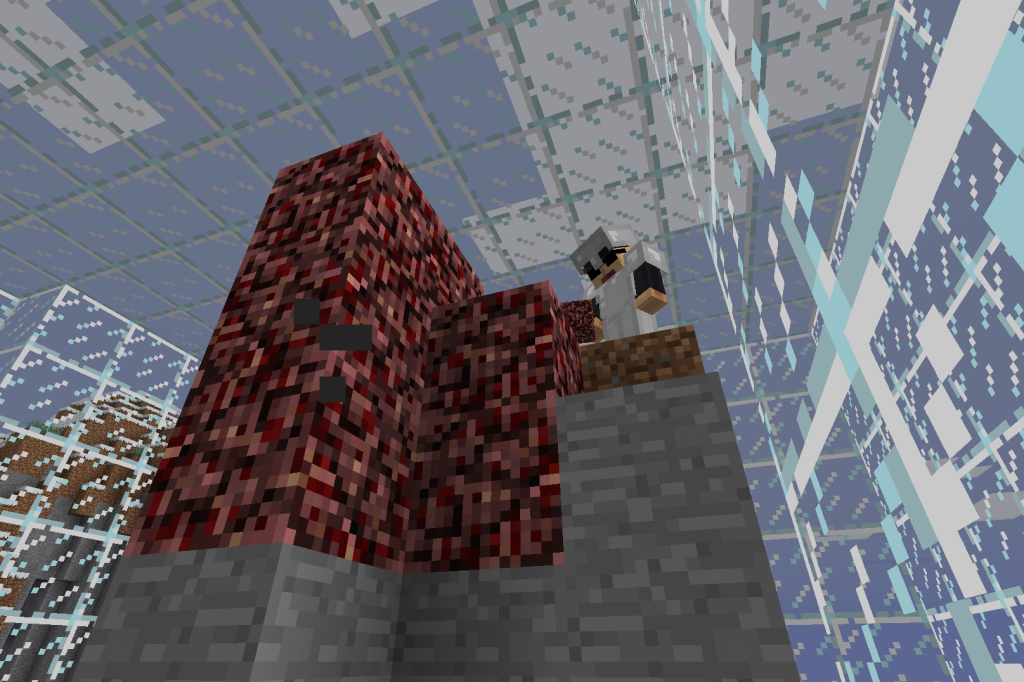
I rode out in my boat to take a look, still in the rain. As I looked back to shore at Nick’s magnificent light house – I knew this would truly be the last “playing the game” moment I’d have in this Minecraft world, and like Jon with his fishing, I took it all in, soaking in one of those very rare moments where you know you’re forming a lifelong memory and you’re living it just then.
Nick’s lighthouse was beautiful, and a testament to his resourcefulness without the blight and easy hand of iron farms and infinite food.
In that beautiful moment I realized that all along what had made the game for me was not digging out stones, or building things, or digging out more stones, or making ever more terrible machinations – what had made the game special was the time spent with my friends, enabling them to realize their visions with some efficiency they would not have had without me – the software engineer who delights in automation and tooling in real life was at his happiest when helping someone with some tool.
It seemed foreign at the time, but after nearly a year of working in self-imposed solitary confinement, telecommuting from home, I realized that though we may be capable of horrific, terrible things; at the end of the day we still need one another, flaws and all.
Without each other we are nothing. Without each other we are Jason flying on a business trip to the middle of nowhere away from friends and family amidst family emergency, playing Minecraft on the Sony Vita, accomplishing incredible virtual triumphs all for naught, accomplishing something we’ll never share with anyone.
I recently realized that life is more than efficiency. Don’t forget to take some time to fish – with your friends.
—
Music: Matthew Good – In a Coma (deluxe edition with the acoustic tracks, naturally.)

